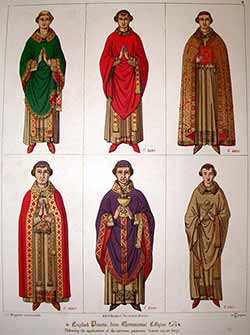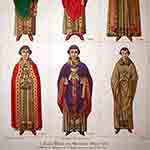
You may not believe, dear reader, that the core content of this post was planned well before the Church of England gained publicity for, at the meeting of its General Synod, debating what clergy are to wear at services. I wasn’t even aware this debate was coming! Prescience? Prophecy?
The 1559 Book of Common Prayer included the “Ornaments Rubric”:
…such Ornaments of the Church, and of the Ministers thereof, at all Times of their Ministration, shall be retained, and be in use, as were in this Church of England, by the Authority of Parliament, in the Second Year of the Reign of King Edward the Sixth.
This rule stayed in place through future revisions – including 1662 and 1928.
Edward VI began to reign on 28 January 1547. During the second year of Edward VI (which began 28 January 1548), clergy and others wore albs, tunicles, dalmatics, copes, chasubles, maniples, mitres, etc. (see image above).
The Church of England has allowed surplice and scarf instead of alb and stole (Canon B8). The recent meeting of its General Synod has relaxed this rule (the change still requires the Queen’s assent). Not wearing what was previously required will be able to be done with the agreement of the parochial church council. And for weddings, funerals, and baptisms, the consent of the principal participants must be gained.
NZ Anglicanism has
The presiding priest at the Eucharist should wear a cassock and surplice with stole or scarf, or an alb with the customary vestments. (NZPrayer Book p.515)
One might note that this is a “should wear” rubric which is ‘weaker’ than, say, “wears” or “shall wear”, and stronger than “may wear” (see my “Rubrics and Grammar” series – Part 1; Part 2; Part 3; The Movie). Rigorist rubricists will notice that what one wears with an alb is in the plural!
What surprised me, in response to the first post in this series, What to Wear? Part 1, I discovered that The Episcopal Church doesn’t have any vesture instructions except in its ordinal. You can find the discussion I initiated around this here.
I also suggest that those who want to explore this in more detail, read the comments, especially by Kurt Hill, in the post, The Bishop’s Mitre. A lot of prejudices (eg. against catholic/universal traditions) are not supported by actual historical scholarship.
In the vast online discussion around the change to the Church of England rule, there are a lot of older people saying that young people would come to church if clergy weren’t robed. Anecdotal evidence is no substitute for causal statistical analysis. My own anecdotal evidence is that robing is not a deterrent to young persons, and that young people are more focused on justice, climate change, and such, than on what many older people think the church should concern itself about. One Anglican priest pointed to a Keep the Church Weird talk and said, “Here is an actual young person reflecting on what attracts GenX and Millennials” – I love the fact that church people think someone nearing 40 is an actual young person! I recently was a visiting preacher and at the conclusion of the service was congratulated concluding with enthusiasm that the church is in good hands with young people like me! End of aside.
Here is what I wrote about vesture in Celebrating Eucharist:
The presider’s vestments can be simple yet beautiful. Stole and chasuble (like the alb) are conservative garments ordinarily worn at the time of Christ (and still worn in many parts of the world). They are not symbolic (efforts to give them symbolic value are “allegorical”). Wearing them can no longer be construed as promoting a certain “churchmanship” or theology of the Eucharist. They are more akin to a uniform. As such they are undergoing modification. The maniple is seldom seen now, many are no longer wearing the girdle, and the stole is now often worn over the chasuble.
The colours of the vestments are an example of signs which require some education to appreciate. Any symbols on vestments need to be simple, visible from a distance, and easily understood. (Do many worshippers know what IHS stands for, or XP?) Large vestments which may be required for a spacious worshiping environment, may be completely out of place in a small chapel, home group, or house communion.
If you appreciated this post, do remember to like the liturgy facebook page, use the RSS feed, and sign up for a not-very-often email, …




I suggest the situation of the Anglican Church (at least) in the 21st century is not an either/or as in either wearing robes will attract young people or not wearing robes will attract young people (or put them off, etc).
Rather we are seeing an evolution in which some liturgies (tending to be ones which follow closely an agreed prayer book service) are drawing in young people and these services are being led by robed leaders (so, robes not an impediment to drawing a crowd) [this well attested by Catholic and Orthodox congregations]; while other liturgies (likely not following a prayer book service so closely, or even not at all, perhaps emphasising an aspect of worship such as music or preaching, and the music Hillsong rather than Mozart) are drawing in young people and these are being led by unrobed leaders (so, robes not necessary for drawing a crowd).
In my experience, the former situation is not improved if the liturgy remains the same but the leaders dispense with robes and the latter situation is not improved if the liturgy remains the same and the leaders begin to robe! There is something to ponder about the coherence of liturgical style and style of dress of its leaders.
So I applaud the CofE changing its rules. Not because it will prescriptively bring about some necessary change but because it catches up descriptively with the situation of diverse liturgical styles currently featuring across its parishes.
A question for ACANZP is when we might catch our rubrics up with what actually happens in our parishes!
Thanks, Peter.
I think you and I are saying similar things – your first sentence of your third paragraph is, I think, especially worthy of reflection.
In my experience, I regularly come across clergy in our church genuinely totally unaware of the rubrics you suggest need changing.
Blessings.
Do you think that unrobed priests (just wearing western Hugo Boss suits) would do well in countries like Kwait, Saudi Arabia, Qatar etc? or, is CofE thinking about evangelizing people there and is not thinking about what liturgical garments should priests / preachers use?
Thanks, Peter. I’m not sure to whom you are addressing your question. I certainly cannot speak for the CofE and its thinking in relation to your question. Blessings.
As a Reder/Licensed Lay Minister in the CofE, I wear robes, when appropriate. Only when I am taking an active part in leading a service of the Word, or Matins or Evensong. Otherwise, robing isn’t appropriate.
Our Clergy robe and stick to the rules. We are not a traditional parish in the sense of being strict, and upto about 10 years ago, Clergy only wore Cassock and Surplice and stole. But succesive incumbents changed that tradition so now they robe as appropriate for a service and the PCC and Congregation now expect it. I’m not sure that the Synod vote will have any effect here in the short to medium term, but who knows what will happen in 10 or fifteen years?
Thanks, “UKViewer”. Firstly – on this site we just use the ordinary name we are known by (rather than anonymously or pseudonymously). It helps maintain the positive feel of this website. Thanks for your reflection from within your context. Blessings.
The CofE move is just one more symptom of the old lady combing her hair while the house is on fire, if you allow me a metaphor. The Church ministry is on fire. Unless tomorrow’s priests are non-stipendiary priests who have a secular job to earn their bread, and unless tomorrow’s bishops are not actual parish-rectors working in collegiality with their neighbouring colleagues, tomorrow there will be no priests to strip any more.
The modern priest and bishop is so much “churchy” in hir everyday life, that [s]he wants the worldly, and therefore doesn’t like vestments, liturgical bread, liturgical wine, liturgical language and prayer in Church; instead of bringing the Church to the world, [s]he brings the worldly into the Church. If the modern priest wishes to be less formal, let hir earn hir bread as everyone else.
The post-modern priest is so busy in hir secular job during the week (so much as the lay churchgoer), that on Sunday [s]he will find totally appropriate to do things as set apart, holy.
Last and not least, the vestments of bishops and priests are traditionally the same. (The Byzantine fashion of putting an imperial tunic and crown on the bishop is modern.) This implies their collegiality, rather than subordination.
Thanks so much for these thoughts, George. I think your point about the priest seeking to move in the wrong direction (making the church more worldly rather than helping sacralise the world) is a key point for reflection. Blessings.